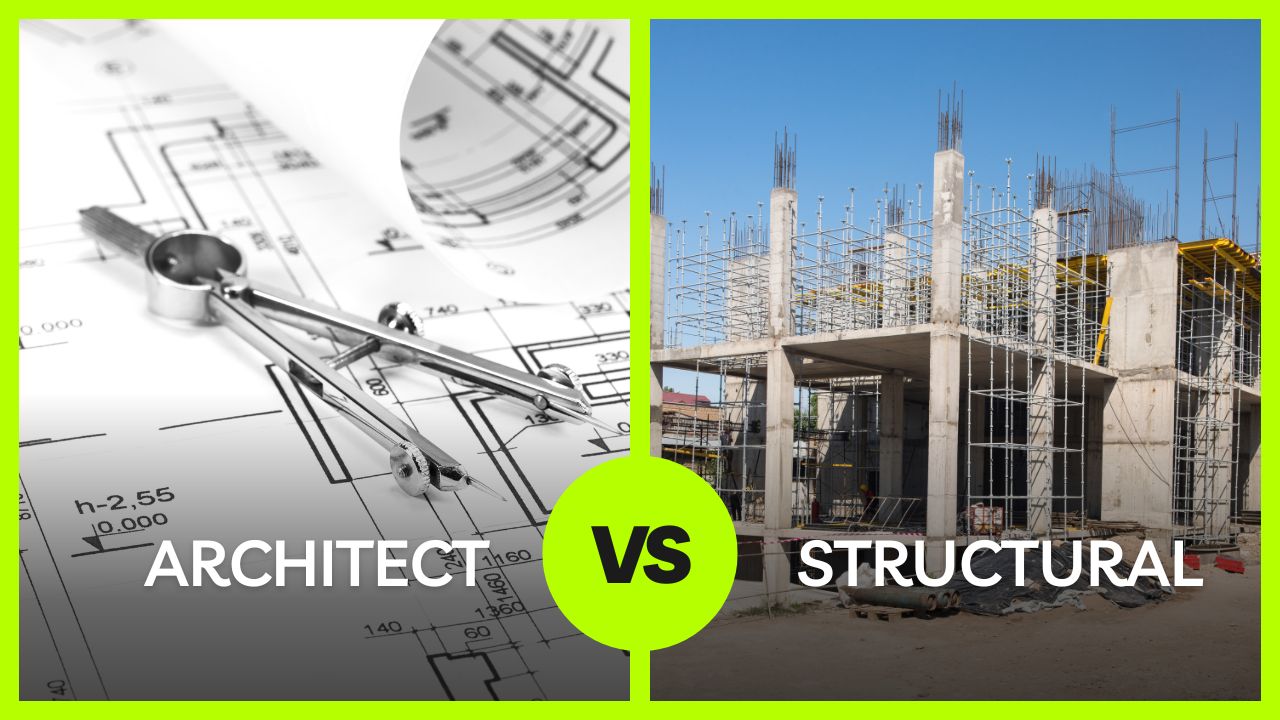Often, the profession of Architect and Structural Engineer are used interchangeably, and in some cases, people’s knowledge about both domains is limited to the fact that they both design buildings. The truth is that architecture and engineering have a lot of sub-fields and disciplines with areas where their work overlaps though there are a few distinct differences between the two.
What do Architects do?

Architects are professionals with a license to build an environment around us. They manage building materials, layouts, and project management by considering physical structure and aesthetics, which is why they are called part scientists and part artists. The profession of an architect involves a creative element to bring a client’s vision to life. An architect is expected to play the role of a designer, manager, adviser, maker, and mediator at any given time, where they are responsible for budgeting, scheduling, and organizing projects by maintaining a collaborative effort with the respective clients. Architects incorporate computer-aided drawings (CAD) to represent their ideas in a virtual form. And with a knowledge of aesthetics, they are expected to come up with solutions that are not only cost-effective but also prioritize optimal efficiency, the functionality of the design, and aesthetics.
What is the Role of a Structural Engineer?

Structural Engineering falls under the domain of Civil Engineering. Commonly, one needs a graduate degree and then a professional engineering license. The duties of structural engineers include the inspection of buildings, similar to the work of civil engineers, but with the inclusion of an understanding of structures and how the environment is affected. Alternatively, structural engineers design buildings though their job is to focus more on meeting safety regulations than aesthetics. For that, structural engineers have a comprehensive knowledge and understanding of laws and codes related to construction permits and materials appropriate for different types of structures so that they stand the test of time and stay safe in the face of natural disasters like earthquakes without bending or buckling down.
Why is it Important to Highlight the Difference between the two?
Now that the roles of both architects and structural engineers have been stated, it is crucial, for anyone looking to start a construction project, to be aware of who they need to hire. For example, for the renovation of one’s home, hiring an architect would be suitable because they can work well with the aesthetics and functionality of spaces. At the same time, structural engineers, in this case, may only be able to help with meeting safety requirements while forgoing the aesthetic viewpoint. There is a reason why the two professions exist separately.
Below is a table to better differentiate the differences between the two professions:
| Aspect | Architect | Structural Engineer |
| Areas of work | Building design, planning, and management – restoration, conservation and refurbishment | Structural analysis, design, and evaluation focusing on safety elements |
| Education required | Bachelor’s or Master’s degree in Architecture | Bachelor’s or Master’s degree in Civil or Structural Engineering or pre-university level diplomas |
| Licensing requirement | Necessary to practice | Necessary to practice |
| Design focus | Aesthetics, function, user experience | Safety, durability, strength |
| Design elements | color, light, tone, proportions, value | walls, columns, materials (concrete, cast iron, etc), beams, and more |
| Collaborative efforts | Works closely with structural engineers, MEP engineers, energy consultants, contractors, and clients | Works alongside architects, MEP engineers, contractors, and clients |
| Project leadership | Generally directs the design procedure in coordination with other specialists | Commonly conducts the structural design and analysis process |
| Examples of projects | Residential and commercial buildings, public spaces, interior design | demolition and rebuilding of structures, solar panel installations, and, multi-family buildings, bridges, tunnels, high-rise buildings, industrial plants |
Architect vs Structural Engineer: Key Differences

Scope of Work: Architect
According to the Oxford dictionary, an architect is defined as “a person who designs buildings and in many cases also supervises their construction”. And therefore, their scope of work includes a variety of tasks other than just working on building new buildings. An architect’s scope of work also includes extension, restoration, conservation, and refurbishment. Their focal point is maintaining marketability, functionality, and an impactful outcome of their project by using their knowledge of aesthetics and practicality. It comes under an architect’s area of work to propose cost-effective solutions without damaging the integrity and value of the property. And of course, an architect does not work alone and needs the assistance of professionals with different expertise such as engineers, energy consultants, and more.
Scope of Work: Structural Engineer
Next, according to the Oxford dictionary, a Structural Engineer is “a person whose job is to plan large buildings, bridges, etc.”. Therefore, a structural engineer’s scope of work involves planning buildings concentrating on safety elements. These safety elements can be the proper use of materials so the structures are strong and do not bend or break. In a way, they focus on the technicalities of a project in terms of the physics behind it. Structural engineers focus less on the aesthetics involved.
What are the Academic Requirements of becoming an Architect and a Structural Engineer?
From an academic viewpoint, both qualifications require good grades. Students may face competition to enter university courses for either of the disciples. Though, the basic level of education or specific subjects needed to pursue the degrees depends from country to country and institution to institution.
Architect
In many countries including the US and the UK, getting a degree in architecture requires a minimum of seven years of professional education which includes up to five years of bachelor’s level and Master’s level qualification and at least two more years of industry experience before a person can apply for a license (for which they must sit specific exams). For some countries, architecture is the lengthiest qualification degree. For example, in the UK, completing a particular exam of licensing is a must to become a certified architect; otherwise, the person cannot refer to themselves as an architect by law. They would then be known as architectural designers.
Structural Engineer
On the other hand, the path to becoming a structural engineer is varied. Students can join apprenticeship schemes after school and learn on the job or they can acquire pre-university level diplomas that can be used to work as trainee-level engineers. The other, safer option is to opt for a Bachelor’s and a Master’s degree in structural engineering. These may not be essential, but a degree can open more opportunities for work in the future. Similar to architects, structural engineers also require affiliation from respective institutions where they can apply for different levels of engineer status. The requirements for licensing may vary in every country.
Examples of Projects
With different areas of expertise, both professions are qualified to lead different kinds of projects. The different types of architectural projects include residential where they specialize in designing homes, and commercial which refers to the designing of non-residential buildings like hotels, malls, etc. Landscape projects focus on planning and building outdoor spaces such as parks and gardens, interior projects focus on designing interior spaces within buildings, and more.
On the other hand, structural engineers may be involved with demolishing and rebuilding structures, foundations, temporary shoring, solar panel installations, and multi-family buildings.
Collaborative Efforts Of Architects & Structural Engineers

Construction projects, whether they include building from scratch, renovation, conservation, or refurbishment, require a lot of work. A lot of work goes on behind the scenes to put together a big project. Thus, different engineers, designers, and planners must work together to build structures that are not only beautiful to look at but are safe and sturdy to be used.
With that collaborative spirit, architects and structural engineers work together on construction projects where architects can help design buildings that the client wants while structural engineers can help locate safety issues and resolve them. Or structural engineers can help architects pick the safest materials within the aesthetic guidelines needed to be met. With a collaborative effort like this, both parties can work together to reduce costs without compromising on structural safety and aesthetic and cultural requirements.
The collaborative efforts actively demonstrate that the chances of success of a project would be more because it will meet all criteria required. Not only will the project be aesthetically cohesive, and attuned to the surrounding environment, but it will also meet safety requirements and regulations. This is bound to reduce the chances of destruction in the face of natural disasters or any unforeseen circumstances.
Advantages Of Hiring An Architect
Architects are experts in the field of design and, because of the requirement of strict licenses, these professionals are bound by law to give specific exams and keep their knowledge up to date as per recent technology, so clients get the best service for their money. Not only that, but architects also have great aesthetic sensibility which means they are creative individuals and they know how to work with the resources at hand, be it colors, textures, structures, materials, and more. With the creative aspect comes the ability to make efficient use of empty spaces which comes in handy especially when designing residential homes or even offices.
In addition, architects are also well-versed in building codes and regulations that need to be met or should be considered when designing buildings. These rules and regulations may vary from country to country and even city to city, but it is crucial to follow them. Architects are referred to as Chief Builders so they are capable of managing other aspects of the construction process which may include budgeting, managing, organizing, and other related tasks. There are also a few very important design elements that architects tend to focus on which include color, light, tone, proportions, value and so much more.
Advantages Of Hiring A Structural Engineer
On the other end of the spectrum, structural engineers bring their own set of expertise and advantages to a project. They are masters in analyzing and designing structures. In the design field, structural engineers focus on buildings’ physical, structural elements. They are experts in analyzing the benefits and disadvantages of a structure in terms of physics and other related laws. With the knowledge of building materials and structural systems, these engineers can select appropriate materials that are efficient, safe, and appropriate for different structures. By hiring structural engineers, clients have the advantage of having the safety and durability of a design at the forefront because their primary job involves assessing the safety elements in designing. This is done by knowing what elements of structural design are to be used, such as the different types of walls, columns, materials (concrete, cast iron, etc.), beams, and more.
FAQs
Who earns more, an architect or an engineer?
It is difficult to generalize the earnings of the two professions but according to statistics, architects may be earning slightly more than engineers. These figures are based on median wages and should not be generalized over the entire spectrum.
Is a structural engineer the same as an architect?
There are similarities between the two, but both work on distinct features when designing buildings.
Can an architect do structural drawings?
By law, architects are allowed to design structures for which they can make use of structural drawings.
Do structural engineers work with architects?
Yes, they do. They also work alongside builders, contractors, and owners.
Is architecture harder than engineering?
Both qualifications are equally as challenging and important within their domains which is why it is difficult to establish their difficulty levels.
What is the cost of hiring architects?
The cost of hiring an architect can vary from $2500 to $8000.
What is the cost of hiring structural engineers?
The cost of hiring structural engineers can fall anywhere between $800 to $3000 but in some instances, the cost of hiring a structural engineer can make up almost 20% of the total project cost.
Do I need an architect if I have a structural engineer?
You may not need an architect if you have already hired a structural engineer. But an architect may be helpful if design and aesthetics are important.
Read More: Structural Engineer in Brisbane
Conclusion
Where there are high possibilities of work overlapping between architects and structural engineers, both bring their distinct qualities to the table. Structural engineers focus on the math and physics elements that help them decide on appropriate materials to use and how to build safe spaces. But architects focus more on the artistic and creative elements of designing, without completely forgoing technical elements. Both professions require certain qualifications in their respective areas of expertise and the same goes for appropriate licensing.
Since both parties bring their respective qualities on board, it is important to collaborate with both on a project so that every aspect, from aesthetics to safety is covered without fail. Each of them is bound to bring their ideas and knowledge so safety and aesthetics can go hand in hand and neither is compromised.
To sum up everything that has been stated so far, it is important to evaluate what your project requires in terms of designing correctly; if you want to focus more on aesthetics or are you more inclined towards safety and structure. The safest option is to work alongside both. No matter the outcome, it is essential to differentiate correctly between the two professions because the more awareness, the better and safer it is in the long run.





